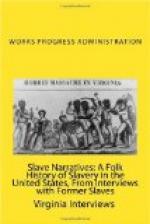“I was laughing at myself just the other day about those homespun dresses and sleeveless aprons I wore as a child. I reckon that was a sign you were coming to ask me about those things. I kept one of those dresses of mine until my own baby girl wore it out, and now I am sorry I let her wear it, for it would be so nice to have it to show you. We wore just a one piece costume in summer and had calico and muslin dresses for Sunday. Wintertime, I wore a balmoral petticoat, osnaburg drawers, and er-r-r. Well, Jacob! I never thought I would live to see the day I’d forget what our dresses were called. Anyway they were of woolen material in a checked design, and were made with a full skirt gathered on to a deep yoke. Uncle Patrick Hull—he was a deep slave belonging to Mr. A.L. Hull—made all the shoes for Marse John’s slaves. We all wore brass-toed brogans.
“Oh, good! I should smile! A better man than Marse John never lived. Nobody better not beat his slaves. Marse John was the postmaster. He married Miss Sallie Eden, and everybody said she was mighty good, but I never knew her for she died when I was a baby. Marse John and his wife, Miss Sallie, had three children. They were: Miss Fannie, Miss Rosa and Marse Allie. Miss Annie Crawford, who teaches in the school here, is Marse Allie’s daughter. She don’t know me so well, but I know mighty well who she is. I think I have already told you that Misses Fannie and Rosa kept house for their brother, Marse John, after their mother died.
“Darling, please get this right: the plantation is a dream to me. If I should try to tell you about it, I am sure it would be only what my mother told me about it in the years long after the surrender. Whether the plantation was the property of Marse John or his father, William H. Crawford, I don’t know, but I am sure there was an overseer, and I am quite sure it was a very large plantation. You know the town of Crawford was named for my white folks. The only thing I can be sure of, from my own memory, is of the things that took place here in Athens.
“Breakfast had to be served promptly at 7:30. When that 9:00 o’clock bell sounded at night, God bless your soul! You had to be in your house, and you had to be in bed by 10:00 o’clock. Marse John never punished but just two of his slaves that I can remember, but I have seen them get several good whippings. They were Ned and William, Aggie’s and Lucy’s boys, and Marse John cowhided them for misbehaving.
“There were jails during slavery time, but Marse John kept his slaves straight himself and did not allow any of them to be taken to jail. I have never seen slaves sold, but I have seen droves of them marching by, being taken to Watkinsville to be sold.




